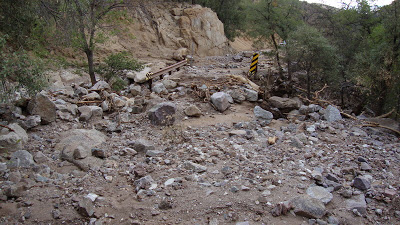Rain, sometimes heavy, fell on my canyon last week and on the surrounding burned area in the Sierra Ancha. An update from the Forest Service on the status of the fire notes that "there is periodic localized flooding occurring in several drainages west of the burned area including Reynolds Creek, Workman Creek, Pocket Creek, Parker Creek, and Cottonwood Creek. ADOT is monitoring the creek crossings of SR 288 for potential damage to the highway infrastructure."
I also note that the USGS stream gauge on South Parker Creek was knocked offline on one of the storm days, June 27, and has remained offline.
So the Arizona Department of Transportation is checking the places where State Highway 288 crosses the Sierra Ancha's streams for flood damage, and some event in South Parker Canyon was big enough to incapacitate the gauge.
What may this mean? I am, of course, thinking about large, post-fire debris flows. (A debris flow is a slurry of water, rock fragments, soil, and mud.)
The USGS Landslides Hazards web page notes that "wildfire can significantly alter the hydrologic response of a watershed to the extent that even modest rainstorms can produce dangerous flash floods and debris flows."
 |
| Results of a post-wildfire debris flow at Carr Canyon Bridge, Huachuca Mountains, Arizona. Photo courtesy InciWeb/ National Wildfire Coordinating Group |
My surprise was due to a lack of knowledge.
With a little research I found Debris-Flow Hazards and Related Phenomena by Matthias Jakob and Oldrich Hungr (Springer/Praxis, 2005) and its observations pertinent to my concerns (Chapter 15,"Wildfire-related debris flow from a hazards perspective," pp. 373-375).
High gradients of terrain and removal of litter and duff (needles, cones, dead branches, etc.) from the forest floor predispose a watershed to flash-flooding and debris flows. The Sierra Ancha Range has steep gradients in abundance, and even moderate-severity wildfire removes protective and absorbent litter and duff. Just because a watershed does not experience a high-severity burn doesn't ensure that it will avoid the kind of runoff that produces floods and debris flows.
So I will continue to worry about long-term damage and wonder what has happened in the Reynolds, Workman, Pocket, and Parker Creek watersheds. Obligations will keep me city-bound for another week or two, but I should be able to go see the situation for myself soon.
No comments:
Post a Comment